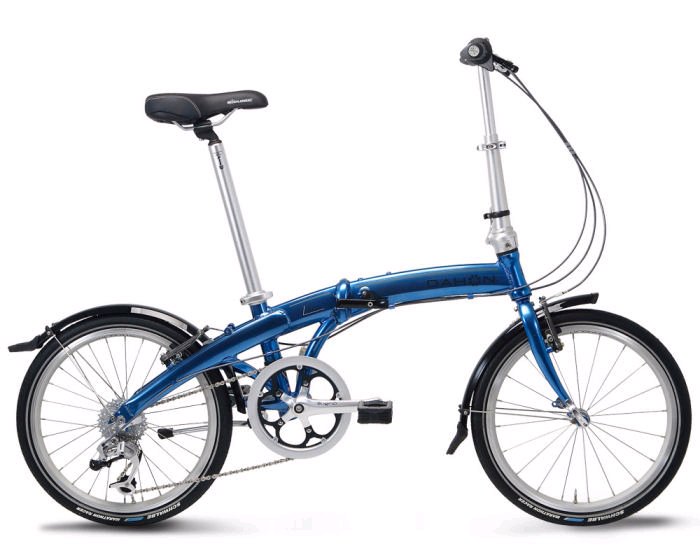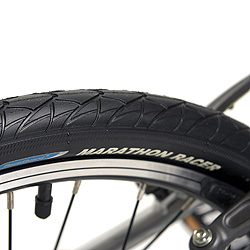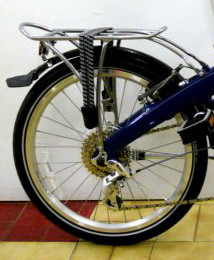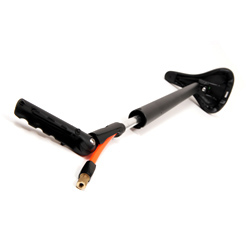
First published 12 May 2009
Dahon is probably the largest specialist folder company in the world, and has also been in the business for a long while. Its appeal to me was originally the wide range, in terms of both type and price – from relatively cheap, simple mounts to ultra light commuting folders, 'mid-range' general purpose machines, sporty and touring models, plus mountain bikes. Available wheel sizes cover 16, 20 & 26 inches and even 700Cs. It should also be noted that many other manufacturers use Dahon to produce their limited ranges of re-badged folders, which surely indicates that they are regarded as knowledgeable and reliable.
Dahon regularly improves its existing models, with updates every year and some new models. The subject of this test, the Mu P8, was a new model for 2007, around the middle of the price range. It uses the exact same frame as the vaunted Mu SL, a far more costly option, but utilises their P range of components – good quality, but sensibly priced.
I have only ridden a few folders over the last two years, and they all felt soggy, imprecise and heavy – which is why I didn’t buy at that time! Then my commute changed, making a folder a really useful option, so I researched on this site and elsewhere on the internet. I read many posts on numerous models, spoke with several dealers across the country by telephone, and the Mu came over as a good choice. I finally made the leap of faith and ordered the P8 without having ridden it.
Although we are in 2008 [when this report was written : Ed], I sought a 2007 model at a good price. I purchased from Rutland Cycling and secured a substantial discount. The only changes for 2008 are a different (slimmer) rear changer, a different frame hinge, and a less attractive paint colour, so in my view there was no contest!
The frame and forks of the Mu are aluminium. The main tube is a patented Dahon section, like a tall oval, with the rear chainstays being very slim and tall. This gives a very strong frame for road shocks, and contributes to the stiff feel to the bike. The frame seems well made and solid, with no obvious flex anywhere in the main frame (see comments later about flex in the stem and handlebars). Folding is via a simple mid-frame hinge, as on most Dahons, and the handlebars fold down - see section 7 for more on folding.
The quoted weight of the P8 version is 11.1Kg (just over 24 pounds). When removed from the box, it certainly felt light, especially as it already has the mudguards and rear rack fitted. It does feel a light machine, as I have now tried several other compact folders to compare it with.
The Mu P8 uses a large diameter seat-post topped with a standard type of saddle mounting, but with the ingenious Dahon built-in pump. The saddle is easily and positively adjusted for fore and aft movement. The seat post itself is marked at 1cm intervals, which makes it slightly easier to set the right height when unfolding – although the marks are somewhat difficult to read. The saddle on the P8 is a ‘Biologic Airflow’– a tad wider than a road saddle, and a little softer. This works well with the frame geometry and stiffness to iron out a good deal of road surfaces in comfort.
The general quality of the standard equipment of the Mu P8 seems very good.

The 2007 model, in a fetching Sky Blue!
Unusually for compact folder, the main frame has a set of bosses to take a bottle cage and/or a mini-pump. Hurrah! The lack of such bosses is annoying, particularly on a machine like this, which tends to encourage one to do more than a simple commute. The mounting holes have plastic plugs in a grey colour, which prevent water ingress until you choose to use them.
Mudguards are standard – they are black, quite deeply curved, and perfectly suit the Marathon Racer tyres. Clearance between the mudguard and tyre is good, so there should be no problems of the wheel getting jammed in muddy conditions, which can happen with certain machines. Mudflaps are fitted to both mudguards, and riding in extremely wet conditions I have not suffered water hitting my back, nor any water thrown off the front tyre onto my shoes or legs, except when going through deep standing water too quickly!
 This
rear rack was/is included in the UK spec. It can be used for some
panniers, but you would need to check for fit and clearance over
the rear changer, and heel clearance.
This
rear rack was/is included in the UK spec. It can be used for some
panniers, but you would need to check for fit and clearance over
the rear changer, and heel clearance.
I use an Altura Urban 15
laptop pannier, fitted on the right side (the frame folds to the
left), after a little persuading of the rack. This obviously adds to
the carrying weight, but lowers the bike’s and my own centre of
gravity for safety and stability.
I have been used to (spoiled by) a 24-speed MTB for some time. However, I do like a gear I can push on, i.e. slightly ‘taller’ than the norm. Hence, when I have commuted with the MTB, I have simply used the largest chainwheel and used only the rear changer. This is exactly what I now do on the Mu. The gear range (32” – 93”) translates to 290%, wide enough for almost anybody and perfect for me. In fact the upper five speeds cover 98% of my riding. The change is slick, snappy and comfortable, even in winter gloves. I must bring the grips to your attention: I have recently fitted full, boltable Biologics to my MTB, which after fine tuning their angle has finally solved my aching wrists after any lengthy rides. Those fitted on the Mu are a great compromise – they are tight on the bars, but can be persuaded to move if you really want to. The support for the palm/ball of the hand is another small factor in the overall comfort which is a highlight of the Mu P8
The Mu P8 has V-brakes, marked 'Avid' (a well-known make), and very nicely finished - no slack, adjustable for reach, and with cable adjustment in the levers. The brakes seem excellent - good feel, just the right amount of travel, progressive braking and enough 'bite' when you need to stop quickly. In my travels across Central London, I have needed to compensate for some atrocious driving (!), but so far have found the braking to be very impressive, and significantly better than on other compact folders I have since tried. Not quite disc levels, but not far behind. Last week, a minibus failed to give way at the markings, continuing directly into my path, prompting an expletive and an emergency stop. Fortunately, the Mu didn’t impact, despite my first impression.
The Mu uses a 40 x 406 sized wheel, with 20” x 1.5” tyres. Standard fitment is the Schwalbe Marathon Racer, which appears to be a very high quality tyre. These are narrower than most BMX or other 20” models, & are recommended to be run at up to 85psi, which is easily achieved, using the on-board seat-tube pump (max 110psi).


The combination of these wheels and tyres is enhanced by the stiff, light frame, giving a sprightly feel off the line. A few well-muscled cycle couriers have been quite surprised by my capabilities on green lights (even if they do trounce me over the next mile). The tubes are fitted with Presta valves, which are slightly uncommon, so I'd advise keeping a tube on board. I will be experimenting with Slime-filled tubes, too.
The folded size of the Mu P8 is quoted on Dahon’s website as 35 x 64 x 77 cm (13.8" x 25" x 30.3"). This is quite compact (aided by the small wheels and short wheelbase), though still larger than a Brompton, but smaller than most other folders. The folded size of the Mu is not likely to be a problem for most people, & it is quite neat and self-contained once folded, with few projecting parts, so you would probably not need to bag it on a tube, etc.
As with all Dahons, the folding process is quite simple and quick, and it does not much matter which order you do the folding operations in, nor does it matter what gear the bike is in (generally I put it in a mid-range gear). Basically the steps are:
The folded frame is held together by a moderately substantial magnetic catch, which is very useful. If you don't carry out step 1 above, you will not be able to bring the two parts of the frame quite together and engage the magnetic 'catch'.
The bike can be stood stably
in
two positions:
a) on the tripod formed by the two wheels and the
bottom of the seat-post. Note that the small plastic lugs on the
sides of the pump could be damaged if care is not taken in this
position.
b) with both wheels on the ground, tip/rotate the bike
backwards until the rear tip of the rack touches the ground to form
another tripod. The rear face of my Urban 15 pannier performs the
same function.
When folded, the chain is on the outside of the package. Once folded, carrying the bike is not too difficult. The best position in terms of grip and balance is to hold the bottom tube, beside the chainwheel. This sometimes dirties the back of your hand, but is a comfortable lift.
Unfolding is the reverse of the folding process, and is also easy and quick.
During the test period (so far), I've used the Mu for three different types of ride:
On the trains I always fold the bike; for my purposes, I find the folding is convenient and the folded size fine, even on packed rush-hour trains, where only the Brompton has an edge.
Overall, the first impression of riding the Mu is the one which persists – the nippy and responsive frame is complemented by the tyres, wheels and saddle, which together provide a good level of smoothness and ride quality. The bike rolls quite freely, making it appear easy to press on and encouraging a pro-active, even assertive style (essential for survival in London!). I find myself humming a tune and smiling at other road users a good proportion of the time.
The riding position is generally quite good, although more upright than my MTB. The wheelbase is quite long, but with the saddle slid right back and the bars lowered somewhat to suit me, I am comfortable even at nearly six feet tall. The saddle itself proved quite comfortable, in all conditions, including the slightly rough towpath. The handlebar grips are superb – see above.
I have not detected any frame flex in any conditions. However, some flex/slack certainly developed in the handlebar/stem system on one cross-town trip. This was due to the stem folding cam bolt gradually loosening, leading to a wobbly feel to the bars! Once on the train, an 8mm spanner corrected this, but three days later it re-appeared. This time, a dose of LocTite was added, since when it has been fine. All of the other quick releases were adjusted at the pre-use service, done at my local dealer, and with a quick tweak to the stem extension, they are all firm after three and a half months of use.
So, aside from tweaking the gear and brake cable adjusters, I have had no work to do on what appears to be a well-designed, well-engineered folder. I am now looking forward to a winter of use, enhancing my fitness, health and my carbon foot-(tyre-?)print, helping my finances and shortening my journeys (compared to buses or underground journeys) – all at the same time!
Dahon - http://www.dahon.com
Dahon UK - http://www.dahon.co.uk